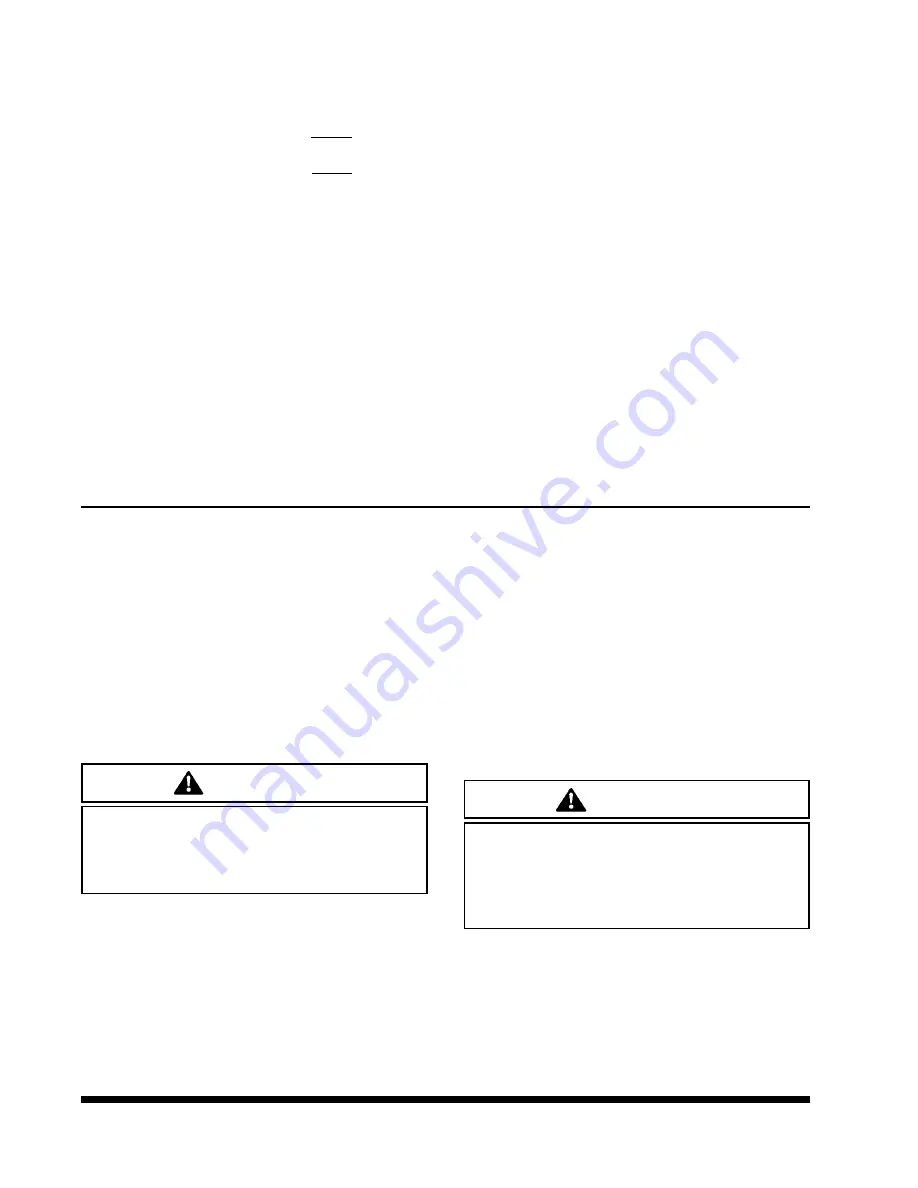
7.
Observe the guide pointer arrow:
If the guide pointer is above the clevis
pointer, adjust clevis CCW for alignment.
If the guide pointer is below the clevis
pointer, adjust clevis CW for alignment.
8.
Reposition clevis until the guide pointer
aligns with the clevis pointer.
9.
Verify by engaging 1/4" pin through the
clevis and guide.
10.
Tighten jam nut to 50 ft.-lbs. torque min.
11.
Remove the guide from cam shaft.
12.
If the push rod threads extend through the
clevis more than 1/16", remove clevis and
cut rod to length.
13.
If the push rod is not fully engaged in
clevis body, install a new push rod - cut to
length.
14.
Install the slack adjuster on the cam shaft.
15.
Rotate the manual adjuster shaft CW until
the slack adjuster arm holes align with the
clevis. Install 1/2" and 1/4" pins and cotter
pins.
c. Adjusting Slack Adjuster
1.
Rotate the manual adjuster clockwise until
brake shoes contact drum.
2.
Back off manual adjuster 1/2 turn.
(counterclockwise)
3.
Manually uncage the spring brake.
4.
Build up vehicle air pressure.
5.
Fully apply and release the brakes several
times to check for adequate clearance to all
adjacent components.
6.
Measure the distance from air chamber to
1/2" pin. Apply brakes with 100-105 psi air
pressure and remeasure distance to 1/2"
pins.
7.
The stroke (difference of these two
measurements) must be less than 2 inches.
4-9 HUB AND DRUM MAINTENANCE
4-9.1
Clean and inspect the brake drums
whenever relining the brakes. To be suitable
for further service, the brake drum should
pass the following checks.
a.
The brake surface should be free of scoring,
excessive heat checks and cracks.
b.
The brake surface diameter should be within
the maximum diameter cast or stamped on
the drum.
c.
The mounting holes and pilot must be round
and true.
d.
The mounting surface must be clean and
flat.
WARNING
FAILURE TO REPLACE FAULTY
BRAKE DRUMS WILL RESULT IN AN
UNRELIABLE BRAKING SYSTEM, AND
MAY LEAD TO AN ACCIDENT.
4-9.2
It may be necessary to turn or resurface
the braking surface to remove small heat
checks or other surface defects resulting
from normal use.
a.
The maximum diameter cast into the back
plate portion of the brake drum is the maxi-
mum diameter or discard diameter to which
the brake drum may be turned or worn and
still be usable. If any portion of the brake sur-
face exceeds the maximum diameter it must
be discarded. The maximum is .120 over the
nominal new diameter unless stated other-
wise on the casting. The maximum diameter
cast into the brake drum supersedes all pub-
lished information.
b.
When resurfacing a drum, allow at least
0.040 inches under the maximum diameter
for additional wear.
WARNING
TURNING A BRAKE DRUM BEYOND
0.040 INCHES UNDER THE MAXIMUM
DIAMETER WILL RESULT IN A
WEAKER BRAKE DRUM AND MAY RE-
SULT IN AN ACCIDENT.
4-9.3
Replacement of the brake drum is re-
quired if any of the following conditions exist:
a.
The brake drum is cracked.
b.
The brake surface is heat checked, grooved
or worn beyond the rebore limit or the maxi-
mum diameter.
4-22
Summary of Contents for 317C
Page 8: ......
Page 14: ...3 2 Figure 3 1 Front Trailer Terminology Figure 3 2 Rear Trailer Terminology...
Page 18: ......
Page 24: ...3 12 Figure 3 5 Steps for Loading and Unloading...
Page 30: ...3 18 Figure 3 10 Dock Leveler Operation...
Page 34: ...3 22 Figure 3 12 Front Extension Bulkhead...
Page 36: ...3 24 Figure 3 13 Rear Impact Guard and Antilock Brake System...
Page 40: ...4 2 Figure 4 1 Lubrication Points...
Page 45: ...4 7 Figure 4 2 317C 318C 319C Wiring Diagram...
Page 46: ...4 8 Figure 4 3 Remote Wiring Diagram...
Page 52: ...4 14 Figure 4 6 Checking Axle Alignment Figure 4 7 Examples of Camber...
Page 56: ...4 18 Figure 4 10 Axle and Brake Assembly...
Page 64: ...4 26 Figure 4 16 Mounting Tires and Wheels Figure 4 17 Stud Tightening Sequence...
Page 67: ...4 29 Figure 4 18 Dock Leveler Leg Assembly...
Page 68: ......
Page 78: ...5 10 NOTES...
















































